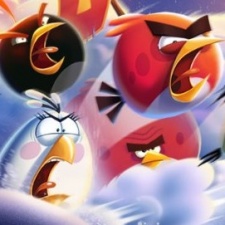This article was co-authored by Digit Games' Om Tandon. This article was originally published on LinkedIn.
You can see more Game UX Deconstructs here. This article is part one of a series, you can read part two, lessons from Playrix, here.
Full disclosure: This article was also co-authored by Deconstructor of Fun's Michail Katkoff, who now works at Rovio.
Why and how are casual games pivoting towards midcore features? What differentiates Angry Birds 2 from all the previous Angry Birds games? We had a close chat with how the team at Rovio built Angry Birds 2 and what led them to make those bold design decisions.
1) Casual games
Casual games is a relatively new genre that was arguably kicked off by PopCap when Bejeweled launched on browsers in 2001. The true growth of the genre was enabled by Facebook and driven by Zynga’s FarmVille and other Ville-style games. The third and largely ongoing growth started in 2012, when King took its popular Facebook game Candy Crush Saga to mobile.
Today, when we talk about casual games, we tend to mean games with relatively simple gameplay, substantial active user base and somewhat limited monetisation potential compared to more advanced games.
In short, casual games are generally targeted at people who may not traditionally consider themselves as gamers.
Casual games like Angry Birds, Candy Crush Saga and Temple Run are typically distinguished by simple rules, reduced demand on time and limited need of skills demanded from the players.
These characteristics sets casual games apart from competitive resource management-oriented games like Clash of Clans, Clash Royale and Game of War.
From a game design and cognitive load perspective, casual games have a straightforward core gameplay loop and simple currency sinks. In general, the session lengths in casual games are around three minutes. In contrast to more ‘core’ games, casual games also require players to do very less cognitive load management.
Why casual games and gamers might be maturing?
In an article published in early 2016 I speculated how masses of casual games players have come a long way since the early days of mobile games.
As time has passed, casual games have been improved with new content and features. While we still play the same ‘old’ match-three, infinite runners and hidden object games, these games offer more deeper experience than their earlier versions did six years ago.
I believe that casual gamers may be maturing due to:
- Mastery of same old game mechanics
- Longevity and familiarity of playing the same genre and mechanics repetitiously
- Wearing off of the novelty value due to a flood of clones
- Introduction of ever deeper designs by game developers
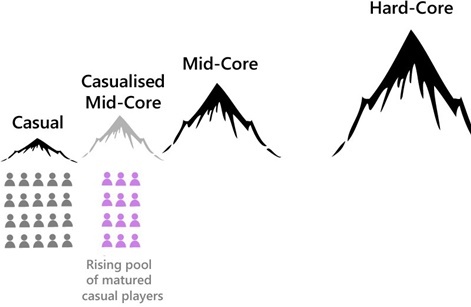
How to design for maturing casual players
This mass of matured veteran casual players may want to make a transition to more intricate gameplay but may be wary of high entry barriers, grinding, wait timers, base building, troop training, managing economies, social pressure of clans and the cognitive load of making strategies that conventional midcore games need (See midcore loops above). All of which casual players hate. This can lead to a vacuum creation.
In short these veteran casual players may find the climb of casual games too shallow, but midcore too steep!
But this gap between casual and mid core genres can also be a window of opportunity.
Let’s look at how some top developers have successfully identified this gap and are experimenting to engage this audience.
Rovio Entertainment
Rovio Entertainment has seen unprecedented growth this year by experimenting and evolving it’s holster of casual games.

Rovio rose to fame with launch of its iconic smash hit Angry Birds title in December 2009, the game with its simple mechanics and ease of use on mobile enchanted masses of casual players and opened the world of games to many first time gamers, across the globe.
The game was also boosted by the rise of iPhone and App Store. The game was simply perfect for the iPhone screen.

Let’s see how Angry Birds has evolved casual games and gamers towards midcore features - with Angry Birds 2, having multiple progression paths, daily quests, Arena and gacha.
Unlike its predecessor, Angry Birds 2 pushed the boundaries of what Rovio had to offer to casual players both in terms of content and mechanics, thereby introducing masses of casual players to more intricate and engaging mechanics commonly found in midcore games.
Angry Birds 2 : Recipe of success

Q&A with Rovio team:
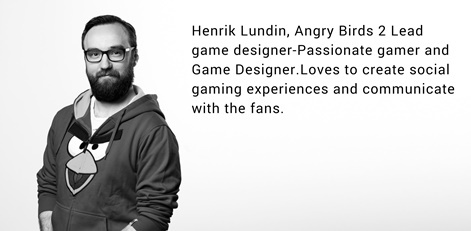
Om Tandon: The number of additional features that AB2 offers compared to AB differs greatly, what was the design thinking behind making such a dramatic change?
Henrik Lundin (Angry Birds 2 lead game designer): With the initial design of Angry Birds 2, we knew that the core of Angry Birds works very well and tampering too much with it wouldn’t make much sense. Therefore we chose to keep the fun core intact and instead focus on the metagame around it.
Knowing that we were making a sequel to a game downloaded billions of times, we needed to build something that we could expand upon for years to come.
A system for leveling and improving the main characters of the game, the birds, hence felt very suitable for the game. Having a leveling system like that requires meaningful features that support that progression and just having a saga map with constant rewards felt very linear and uninteresting.
That’s why the Daily Challenge and Arena features got added, where the players are put to the test to further increase their rewards and progression.
Om Tandon: When making such drastic changes, were you ever worried that it might add layers of complexity to the essence of what made the original title such a hit? Were you worried that it may perplex your existing casual player base? If yes, what precautions did you take to mitigate it?
When a new player started the game, our goal was that it should feel very familiar to classic Angry Birds. They had their saga map, they had the birds and pigs and they progressed through different chapters. As the player gets more used to the game we start unlocking features that are slightly more complex.
Something that might make Angry Birds 2 stand out from other games with higher complexity is our specific design aim for very spacious user interface.
Features are not hidden behind menus or in long lists, they are all exposed and playful in their words which contributes to a more approachable user experience.
If players feel like they rather play a certain feature over the other we are not stopping them from doing so, every player is different in how they consume their entertainment.
AB2 Similarities with midcore loops:
The game has multiple paths of progression. Unlike its predecessor, where players had a single track linear progression path of beating a set number of levels to move to next world, AB2 offers a variety of parallel and intertwined progression arcs.
a) Player account level up
Player levels up by collecting stars. This account level is used to gate features such as the daily quests, daily challenge, and the Arena mode. An account level incentivises the player to replay levels until they are three-starred.

b) Birds level up: Crafting, fusion and components
Players can level up birds increasing the destruction points they generate upon collision. Points not only allow to get that coveted three-star-rating but they also contribute to getting the additional bird to sling.

As soon as players have enough feathers to upgrade a bird, they are prompted to do so, similar to character levelling up in midcore games like Marvel Contest and Star Wars: Galaxy of Heroes.

Players can also buy functional goods like hats, which are much like fitting components in many midcore games which multiply birds destruction power also creating more currency sinks. Levelling up requires feathers which are earned through gacha and daily rewards.

Q&A with Rovio team:
Om Tandon: Was the switch to evolving birds andthe introduction of light crafting and fusion mechanics purely driven by the free-to-play nature of the game? Or were there any other reasons to introduce these mechanics?
Henrik Lundin (Angry Birds 2 Lead game designer): With Angry Birds 2 we wanted to give the players more than just a saga map. We wanted to:
- Focus more on the characters of the game
- Offer different flavors of progression without removing any of the previous features.
If the player cares more about the characters they are more likely to engage with the game and try out different features. In the game there are several vectors of progression, but in the end they all feed back into improving your birds. This helps with keeping the complexity low while still offering a variety of features to play.
If we didn't add these new features to the game, it would be very hard to scale and expand upon. Today the game is doing very well and is in a healthy state, that might not have been possible unless we branched out early on.
Om Tandon: How did the players respond to all these change?
Henrik Lundin (Angry Birds 2 Lead game designer): The reaction from our fans have been very positive whenever a new engaging feature is released. When we released the hats into the game there were suddenly new goals for players and they got to choose what their birds should look like.
We think it's a very positive change to have a sense of choice when playing, no matter if it’s how their birds look or if they would rather play a certain feature over the other.
c) Slingshot level up
To level up the slingshot player first needs to unlock all the birds, which requires beating the first 44 levels. This creates more rewards and goals for mid-level players, removing the linearity of just beating levels with added incentive.
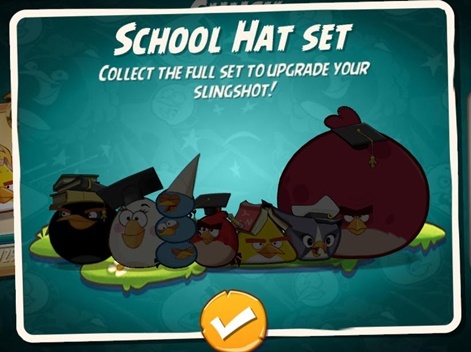
Q&A with Rovio team:
Om Tandon: It seemed like the design team added multiple level ups and progression paths which are intertwined. What was the motive and incentive behind them and how did you ensure players understood all these different paths without getting overwhelmed?
Måns Wide (Angry Birds 2 Executive Producer): The saga map progression is easy to understand and quite effective in casual games, but it has a lot of limitations.
It’s hard to push seasonal content when all the players are sitting at totally different places in a huge map. Also, focusing on progressing the characters seemed like a logical move since people really relate to the birds. Levelling your beloved bird-makes is more rewarding than just moving from level to level.
As what comes from protecting players from becoming overwhelmed, we unlock the features one at a time. We also try to balance the game so that the players will never get too much new information at the same time.
2) Introduction to gacha
Gacha systems are a huge hit with midcore and hard-core players as it adds an element of luck and anticipation which a lot of players find thrilling, immense success of social casino games with a casual player base is also a strong testament of how thrilling luck-based features are for players.
AB2 makes use of this in two ways
1. Daily chest and reward mechanics which offers players a free chest with rewards every half an hour and conditioning and habituating them to free rewards and paid premium chests if player wants more items.

2. Tower of Fortune: This is an interesting and engaging daily rewards mechanics which makes great use of behavioral economics principle of “Loss Aversion”
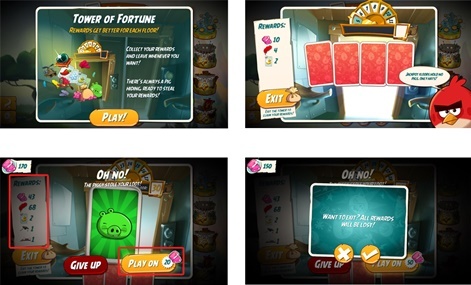
The Tower of Fortune is a daily reward mechanic with players having a 75 per cent chance of winning and 25 per cent chance of losing.
Each floor of the tower gives player three rewards and one chance of losing all previous and current rewards if he chose a card with a pig on it. But as you can see in the example above, once a player has racked up multiple rewards from subsequent rounds and they encounter a pig, the cost of losing the rewards they have accumulates and is much greater than what they need to pay to continue playing.
This leads to a situation of “loss aversion” where players are less likely to let go of what they have already earned by paying a small fee/fine, rather then let go of all that they know they have won for sure.
Q&A with Rovio team:
Om Tandon: What was the inspiration behind introducing the gacha system to your casual player base audience? Why did you think such a mechanic would be a hit?
Henrik Lundin (Angry Birds 2 Lead game designer): Random-based rewards have since long proven to work on games, as it’s both fun and exciting for players.
Having several ways of progressing in our game, using different resources, it made a lot of sense to introduce gachas to the game.We have definitely taken considerable measures to be very clear about gatchas.
We take care to visualise clearly the opening of a chest so players understand what is going on. An important part of our interface when opening these chests is that all rewards are automatically added to where they belong with a clear visual animation.
This helps players understand why they got the resource and what it is good for. If that hadn't existed we could have ended up in a situation where players received rewards that were both unclear in function while also just taking up space in some inventory.
Om Tandon: What was the player response to chests and the Tower of Fortune in terms of engagement?
Måns Wide (Angry Birds 2 Executive Producer): The Tower of Fortune had a huge impact on the game, mostly in terms of gem spent. As it is now, 30 per cent of all hard currency is spent in there.
In terms of engagement it’s harder to say since we pushed the new start screen - a huge change in the game - about a month after introducing the Tower. So it is not trivial to see what’s the root of the positive trends in terms of engagement and retention.
Om Tandon: What do you think of our hypothesis? Was AB2 targeted at engaging and maturing the existing casual player base? Or did you plan to make it more appealing to midcore users as well?
Henrik Lundin (Angry Birds 2 Lead game designer): Angry Birds in general is a brand with a broad appeal, that is something we wanted to keep intact by making the game approachable for everyone.
As we are introducing more midcore features to the game, it is our responsibility to make it understandable even for casual players.
We believe that creating more depth in the game is good for both our players and ourselves in terms of scalability, but we’re definitely taking baby steps into the midcore features.
For example, there is little inventory management in the game, meaning most of the flows in the game are streamlined towards the player progressing. If our players take part of an event, they’ll gather resources and improve their birds - it’s not more complex than that.
There is always a fine balance between keeping the game approachable but deep enough to satisfy most of our players.
The best part about the game is that it’s all optional, our players can choose to spend their time in the game wherever they want without being blocked from other content.
It might take months for a casual player to change their playing behaviour to a more midcore style, but as they do I think Angry Birds 2 is a good gateway into the midcore market.
3) Arena and social features
Every three hours, the player receives a Ticket, which allows them to enter the Arena. In the Arena, a player goes head to head against other players in an asynchronous battle of Angry Birds.
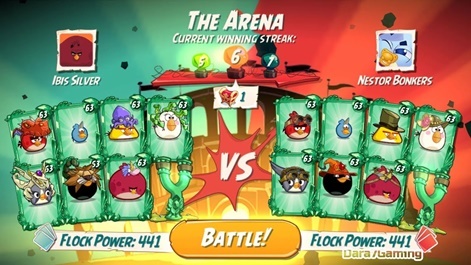
Q&A with Rovio team:
Om Tandon: Arena battles were clearly a big move towards adding more social attributes to the game, do you think that objective was achieved with this mode?
Henrik Lundin (Angry Birds 2 Lead game designer): The Arena in Angry Birds 2 played two big roles in the game.
The first was definitely to make it more social, seeing other players and having fun playing against another player. The second, but maybe the most successful, reason is to give players who like to compete a place to do so.
I believe that even a player who is more casual can get a thrill out of knowing they play against someone else, and feeling great when they manage to win.
Competitiveness exists in everything we do in our ordinary lives, so it’s all about how you present the challenge to the player.
In our game you play a level just like any part of the game, the only difference is that you play against your opponent's final score. This means that there’s no great barrier to overcome making it more accessible.
As the player wins they can climb in leagues and earn good rewards for it, further encouraging players to engage with the game.
Om Tandon: What are the future trends that you see for your casual and midcore players, and what new features can we expect from AB2 in future?
Måns Wide (Angry Birds 2 Executive Producer): Dynamic live-ops content engages players in midcore games nowadays. We’ll add a lot of urgency to the game; stuff that happens here and now. With the clans and global leaderboards it makes sense to put more focus on social features and collaboration.
Om Tandon: Any advice to other developers who are building casual games to leverage the engagement, social and monetisation aspects of their game in this crowded space?
Lundin: I would start by pointing out that just because a game is casual doesn’t necessarily mean it’s shallow. Everything comes down to how you present information to the player in an approachable way so they don’t feel lost and confused along the way.

When you’re creating your game you should design for it to live for years, that means you have to have smart systems in place that can scale and engage players for a long time. In support of that I would not look too much in the past way of making casual games where the core game was 90 per cent of the experience.
I believe that future games will have a much stronger meta game that can stand on its own feet, only to be enhanced by a fun core game. When players start engaging in an interesting meta game, by playing a fun core game, you will have a very good game on your hands.
Om Tandon: What would you call the secret sauce behind the success of Angry Birds 2?
Mia Lähteenmäki (Rovio User Research Lab): To me it seems that the Angry Birds 2 team does have a secret sauce indeed, and I see there three major ingredients. At the general level they are domain expertise, systematic learning and understanding users. It is however possible to identify these ingredients more closely:
1) The game designers’ skills: Game genre skills and ability to adapt from existing knowledge of games. They have been able to distill all this into something totally new for this specific game and game genre.
2) Developing design principles: When they are developing new things and making iterations to make game work better, they have made efforts to develop them as learnings. As a consequence, they have been able to develop a set of general design principles that work for the game, some of which has been discussed above. This also helps keeping the game design consistent now and in the future, when new features are introduced.
3) Understanding and listening to players: This happens not only through analytics insights, but also by seeking understanding through other channels. For example, the game development team, including the product leads, have been active on our fan sites and social media like Facebook. So if you go and ask them what the players think about this or that, they are able to answer.
Conclusion
From the analysis above we can safely conclude:
1) Players maturing is a rising trends. It is possible for developers to mature and transition casual gamers into more midcore and competitive gameplay via the introduction of midcore features in a mild and phased manner for ultra casual games.
2) Casual games developers can extend the shelf life of their games and add more scalability and depth to create more immersive experiences by pivoting to midcore features in an accessible and acceptable way.
In part two of this series we will talk to another blockbuster casual mobile games developer, Playrix, of Gardenscapes, Homescapes and Fishdom fame, and their take on maturing casual games and gamers. Stay tuned.

